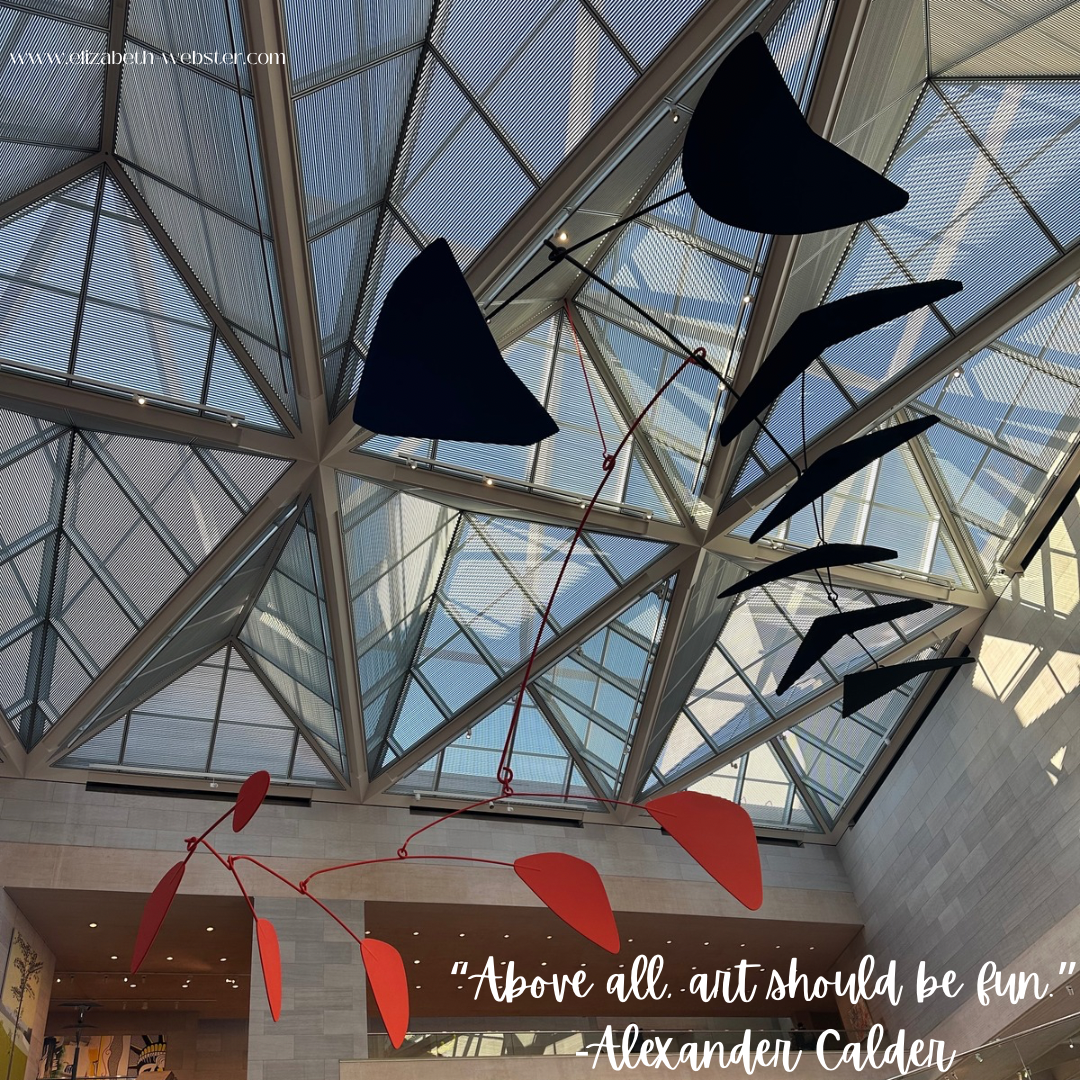Calder and Community
Calder, Alexander. “Untitled,” aluminum and steel, 1976. National Gallery of Art, Washington, D.C. Image by author.
During the Thanksgiving holiday, I visited family members who live in Maryland. We decided to spend a full day with the kids in Washington D.C. Every time I’ve set foot on the National Mall, I’ve been overcome with a feeling akin to hunger. And my eyes have always been bigger than my stomach there. Our day in the nation’s capitol, sunny and brisk and remarkably uncrowded, was no different. The feeling was still there. I wanted to do everything immediately - and all at once.
Fortunately, shepherding children through a city requires adults to pace themselves, too. The kiddos forced us to pause, to celebrate the quality of an experience over its quantity, and - thank goodness - to find snacks at every available opportunity. (Because I know various family members will read this, I’ll acknowledge what they’re all thinking: I’m a better person with access to snacks as well. Go figure.)
We opted to begin the day with a break. In an early effort to boost morale, we took a circular route to the National Gallery of Art through its Sculpture Garden. Our littlest ones squealed as soon as we entered. I imagine that sculptures as big and bright as a playground structures - sculptures that look like fun but have been defined by grown-ups as “art” - hold immeasurable appeal for obvious reasons.
Almost immediately, my son was drawn to Alexander Calder’s Cheval Rouge. Created in 1974 from painted sheet metal, the abstract sculpture has the familiar, sinewy lines of a horse - and the surprise of something entirely new.
Calder, Alexander. “Cheval Rouge,” painted sheet steel, 1974. National Gallery of Art, Sculpture Garden, Washington, D.C. Image by author.
Inside the National Gallery, he loved Calder’s massive mobile, Untitled. Calder famously described the awe-inducing experience of witnessing his mobiles as “[w]hen everything goes right, a mobile is piece of poetry that dances with the joy of life and surprise!” Calder died a year before his mobile was installed, but I think he would’ve been delighted with our joyful responses to his work.
Since returning home, I’ve gone down a bit of a Calder rabbit hole. While I admire his art, I admire the collaborative spirit underpinning his creative process even more. Following a move to Paris in 1929, Calder acquired a circle of trusted artist friends. He wasn’t jealous of them. He didn’t compete with them. Instead, found their talent inspiring - and their artistic vision moved him to find his own.
In 1930, Calder visited Piet Mondrian’s studio. He described the experience with wonder:
“It was a very exciting room. Light came in from the left and from the right, and on the solid wall between the windows there were experimental stunts with colored rectangles of cardboard tacked on …. I suggested to Mondrian that perhaps it would be fun to make these rectangles oscillate. And he, with a very serious countenance, said: ‘No, it is not necessary, my painting is already very fast’ …. This one visit gave me a shock that started things.”
From that point forward, Calder resolved not only to create abstract art but its movement too.
He utilized his engineering background to make his creations - and found friendship rooted in his artistic impulses. Marcel Duchamp, another proponent of the boundary-pushing “kinetic art” field, gave Calder’s creations their name. In the fall of 1931, he called them “mobiles.” Now, nearly a century later, so do we -and we recognize Calder as the person who invented them. Duchamp’s generous description referenced his own art. Linda Dalrymple Henderson detailed their reciprocal relationship: “[F]rom the 1930s to the 1960s the two artists were, in fact, close friends, who individual art practices were marked by their rich interchanges.”
Calder supported emerging artists, too. When a twenty-something Ellsworth Kelly was coming up in the art world, Calder reached out to museums on his behalf. He even paid for his studio space at one point. They kept up a lively correspondence for years. While Calder didn’t consider himself Kelly’s mentor, he certainly used his industry clout to support him. Perhaps Calder scoffed at the loaded idea of mentorship because he was simply for Kelly what other artists had done for him; where he could, he raised another artist up.
Throughout his career, Calder’s artistic community walked alongside him. Their wisdom helped him find his path forward. And, in an ever-evolving exchange, he offered his intuitive sense for line and structure and play back to them.
That’s the point that I’ve been making to children. As much as we remain enthralled with Calder’s artistic contributions, I think we should admire the way he lived his life as well. Making art should feel like play - but playing well with others has always been and will always be the most important part.

